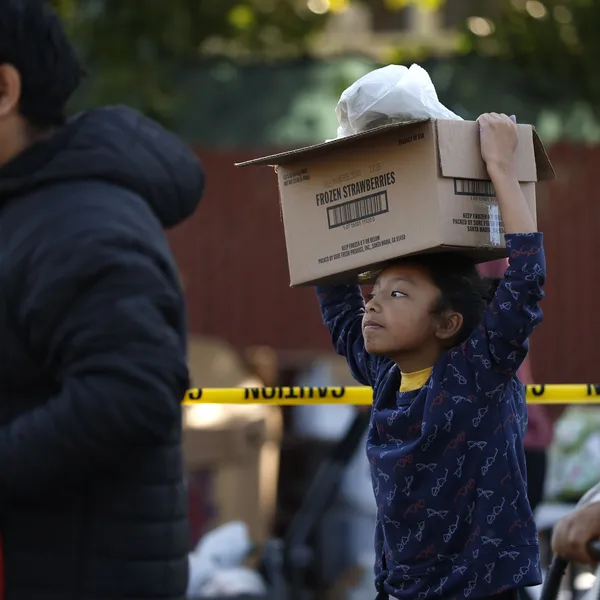
Three children play together at Little Flowers Early Childhood and Development Center located in the Sandtown-Winchester neighborhood of Baltimore, Maryland, on January 11, 2021.
New Report on Pandemic-Era Funding Shows 'Childcare Crisis Is a Policy Choice'
"Childcare is a public good and needs robust federal investment to maintain progress that was made with relief funds and to avoid further crisis," reads an analysis.
With the last of the federal childcare funding included in coronavirus pandemic relief set to expire at the end of September, two civil society groups on Thursday released an analysis of the "significant benefits" the funding included for families and early childhood educators across the U.S.—showing that the federal government could, and "must," gain control of the nationwide childcare crisis with robust investments.
Published by the National Women's Law Center (NWLC) and the Center for Law and Social Policy (CLASP), Cliff Notes: Key Takeaways From Pandemic-Era Child Care Relief and the Child Care Funding Cliff analyzes the childcare benefits included in the American Rescue Plan Act (ARPA) of 2021, which provided $24 billion in childcare stabilization grants and $15 billion in supplemental money for the existing Child Care and Development Block Grant (CCDBG)—the latter of which is set to expire September 30.
The funding helped stabilize 220,000 childcare programs across the country, according to the report, assisting centers to pay staff members, rent, and continue providing services to families. A 2022 survey of childcare programs by the National Association for the Education of Young Children (NAEYC) showed that the funding also allowed 75% of respondents to pay employees sufficiently, with 53% providing bonuses and 38% increasing baseline wages in a notoriously low-paying industry.
When the childcare stabilization grants expired last September, Thursday's study found, it was felt across the country by families and childcare workers alike. Twenty-nine percent of families faced higher tuition due to rising operating costs for providers, and as employees told NAEYC in another survey in February 2024, staff shortages led to increased burnout among early childhood educators.
"Childcare is a public good and needs robust federal investment to maintain progress that was made with relief funds and to
avoid further crisis," reads a fact sheet accompanying the report by NWLC and CLASP.
The $15 billion in supplemental CCDBG funding set to expire at the end of the month allowed states to make "substantial improvements to their childcare assistance policies," which in turn eliminated waiting lists for childcare assistance, expanded eligibility for assistance, lowered or waived copayments for families, and increased payment rates to providers.
Now, said the groups, "the United States can and must make long-term investments in women, children, and families."
Melissa Boteach, vice president of childcare and income security at NWLC, said Congress must pass "$16 billion in emergency relief, alongside long-term investments, so that families and early educators can have the robust, fully funded childcare system that they need and deserve."
The report emphasizes that the U.S. government "has the resources to fulfill this vision," using as an example tax cuts for the wealthiest Americans that were included in former Republican President Donald Trump's 2017 Tax Cuts and Jobs Act.
"The soon-to-expire $15 billion ARPA supplemental CCDBG discretionary funding was a drop in the bucket compared to the amount of revenue lost from decades of tax cuts for the wealthy and large corporations," reads the report. "We can't afford to put off investing in early learning and childcare any longer, and we have an imminent opportunity to raise public dollars to support investments in childcare. In 2025, some provisions of the 2017 Tax Cuts and Jobs Act are scheduled to expire. If we allow the tax cuts for the wealthiest to expire and make additional progressive changes to the tax code, we could raise trillions of dollars in tax revenue that could support investments in women, children, and families."
Increasing the law's federal corporate tax rate from 21% to 28% would raise $1.35 trillion over 10 years, "which could fully fund President [Joe] Biden's childcare proposal twice over and still have money left over," reads the report.
The report makes clear, said Boteach, "that public investment in childcare works, and that our current childcare crisis is a policy choice."
The report was released as U.S. Rep. Ro Khanna (D-Calif.) prepared to introduce a bill that would cap childcare costs for families earning under $250,000 per year at $10 per day, modeled on a Canadian initiative. The proposal includes a grant program that would allocate $780 billion over 10 years to fund childcare providers.
"As a father of young kids, I understand how difficult this is for families," Khanna told Time magazine. "Particularly for those who are away from grandparents or uncles or aunts and are working or middle class. But I also think that it is fundamental to giving people a fair shot at the American dream—that the biggest investment we can make is in young children to have a big economic return."
Unless the federal government makes a "significant and sustained" investment in childcare, said Stephanie Schmidt, director of childcare and early education at CLASP, "the challenges and inequities plaguing the childcare sector will worsen and states will backslide on the progress they achieved using the relief funds to make care more affordable and easier to find."
An Urgent Message From Our Co-Founder
Dear Common Dreams reader, The U.S. is on a fast track to authoritarianism like nothing I've ever seen. Meanwhile, corporate news outlets are utterly capitulating to Trump, twisting their coverage to avoid drawing his ire while lining up to stuff cash in his pockets. That's why I believe that Common Dreams is doing the best and most consequential reporting that we've ever done. Our small but mighty team is a progressive reporting powerhouse, covering the news every day that the corporate media never will. Our mission has always been simple: To inform. To inspire. And to ignite change for the common good. Now here's the key piece that I want all our readers to understand: None of this would be possible without your financial support. That's not just some fundraising cliche. It's the absolute and literal truth. We don't accept corporate advertising and never will. We don't have a paywall because we don't think people should be blocked from critical news based on their ability to pay. Everything we do is funded by the donations of readers like you. Will you donate now to help power the nonprofit, independent reporting of Common Dreams? Thank you for being a vital member of our community. Together, we can keep independent journalism alive when it’s needed most. - Craig Brown, Co-founder |
With the last of the federal childcare funding included in coronavirus pandemic relief set to expire at the end of September, two civil society groups on Thursday released an analysis of the "significant benefits" the funding included for families and early childhood educators across the U.S.—showing that the federal government could, and "must," gain control of the nationwide childcare crisis with robust investments.
Published by the National Women's Law Center (NWLC) and the Center for Law and Social Policy (CLASP), Cliff Notes: Key Takeaways From Pandemic-Era Child Care Relief and the Child Care Funding Cliff analyzes the childcare benefits included in the American Rescue Plan Act (ARPA) of 2021, which provided $24 billion in childcare stabilization grants and $15 billion in supplemental money for the existing Child Care and Development Block Grant (CCDBG)—the latter of which is set to expire September 30.
The funding helped stabilize 220,000 childcare programs across the country, according to the report, assisting centers to pay staff members, rent, and continue providing services to families. A 2022 survey of childcare programs by the National Association for the Education of Young Children (NAEYC) showed that the funding also allowed 75% of respondents to pay employees sufficiently, with 53% providing bonuses and 38% increasing baseline wages in a notoriously low-paying industry.
When the childcare stabilization grants expired last September, Thursday's study found, it was felt across the country by families and childcare workers alike. Twenty-nine percent of families faced higher tuition due to rising operating costs for providers, and as employees told NAEYC in another survey in February 2024, staff shortages led to increased burnout among early childhood educators.
"Childcare is a public good and needs robust federal investment to maintain progress that was made with relief funds and to
avoid further crisis," reads a fact sheet accompanying the report by NWLC and CLASP.
The $15 billion in supplemental CCDBG funding set to expire at the end of the month allowed states to make "substantial improvements to their childcare assistance policies," which in turn eliminated waiting lists for childcare assistance, expanded eligibility for assistance, lowered or waived copayments for families, and increased payment rates to providers.
Now, said the groups, "the United States can and must make long-term investments in women, children, and families."
Melissa Boteach, vice president of childcare and income security at NWLC, said Congress must pass "$16 billion in emergency relief, alongside long-term investments, so that families and early educators can have the robust, fully funded childcare system that they need and deserve."
The report emphasizes that the U.S. government "has the resources to fulfill this vision," using as an example tax cuts for the wealthiest Americans that were included in former Republican President Donald Trump's 2017 Tax Cuts and Jobs Act.
"The soon-to-expire $15 billion ARPA supplemental CCDBG discretionary funding was a drop in the bucket compared to the amount of revenue lost from decades of tax cuts for the wealthy and large corporations," reads the report. "We can't afford to put off investing in early learning and childcare any longer, and we have an imminent opportunity to raise public dollars to support investments in childcare. In 2025, some provisions of the 2017 Tax Cuts and Jobs Act are scheduled to expire. If we allow the tax cuts for the wealthiest to expire and make additional progressive changes to the tax code, we could raise trillions of dollars in tax revenue that could support investments in women, children, and families."
Increasing the law's federal corporate tax rate from 21% to 28% would raise $1.35 trillion over 10 years, "which could fully fund President [Joe] Biden's childcare proposal twice over and still have money left over," reads the report.
The report makes clear, said Boteach, "that public investment in childcare works, and that our current childcare crisis is a policy choice."
The report was released as U.S. Rep. Ro Khanna (D-Calif.) prepared to introduce a bill that would cap childcare costs for families earning under $250,000 per year at $10 per day, modeled on a Canadian initiative. The proposal includes a grant program that would allocate $780 billion over 10 years to fund childcare providers.
"As a father of young kids, I understand how difficult this is for families," Khanna told Time magazine. "Particularly for those who are away from grandparents or uncles or aunts and are working or middle class. But I also think that it is fundamental to giving people a fair shot at the American dream—that the biggest investment we can make is in young children to have a big economic return."
Unless the federal government makes a "significant and sustained" investment in childcare, said Stephanie Schmidt, director of childcare and early education at CLASP, "the challenges and inequities plaguing the childcare sector will worsen and states will backslide on the progress they achieved using the relief funds to make care more affordable and easier to find."
- 'Families' Needs Over Corporate Greed': US Childcare Providers, Parents Hold Day of Action ›
- JD Vance's Solution to Childcare Crisis? 'Maybe Grandpa or Grandma Wants to Help' ›
- Childcare Crisis Grips US as IRS Chief Says Wealthy Tax Dodgers Cost $150 Billion a Year ›
- Opinion | The US Childcare Crisis Is Finally an Election Issue | Common Dreams ›
- Trump Gutting of GSA Office Puts Dozens of Federal Childcare Centers at Risk | Common Dreams ›
With the last of the federal childcare funding included in coronavirus pandemic relief set to expire at the end of September, two civil society groups on Thursday released an analysis of the "significant benefits" the funding included for families and early childhood educators across the U.S.—showing that the federal government could, and "must," gain control of the nationwide childcare crisis with robust investments.
Published by the National Women's Law Center (NWLC) and the Center for Law and Social Policy (CLASP), Cliff Notes: Key Takeaways From Pandemic-Era Child Care Relief and the Child Care Funding Cliff analyzes the childcare benefits included in the American Rescue Plan Act (ARPA) of 2021, which provided $24 billion in childcare stabilization grants and $15 billion in supplemental money for the existing Child Care and Development Block Grant (CCDBG)—the latter of which is set to expire September 30.
The funding helped stabilize 220,000 childcare programs across the country, according to the report, assisting centers to pay staff members, rent, and continue providing services to families. A 2022 survey of childcare programs by the National Association for the Education of Young Children (NAEYC) showed that the funding also allowed 75% of respondents to pay employees sufficiently, with 53% providing bonuses and 38% increasing baseline wages in a notoriously low-paying industry.
When the childcare stabilization grants expired last September, Thursday's study found, it was felt across the country by families and childcare workers alike. Twenty-nine percent of families faced higher tuition due to rising operating costs for providers, and as employees told NAEYC in another survey in February 2024, staff shortages led to increased burnout among early childhood educators.
"Childcare is a public good and needs robust federal investment to maintain progress that was made with relief funds and to
avoid further crisis," reads a fact sheet accompanying the report by NWLC and CLASP.
The $15 billion in supplemental CCDBG funding set to expire at the end of the month allowed states to make "substantial improvements to their childcare assistance policies," which in turn eliminated waiting lists for childcare assistance, expanded eligibility for assistance, lowered or waived copayments for families, and increased payment rates to providers.
Now, said the groups, "the United States can and must make long-term investments in women, children, and families."
Melissa Boteach, vice president of childcare and income security at NWLC, said Congress must pass "$16 billion in emergency relief, alongside long-term investments, so that families and early educators can have the robust, fully funded childcare system that they need and deserve."
The report emphasizes that the U.S. government "has the resources to fulfill this vision," using as an example tax cuts for the wealthiest Americans that were included in former Republican President Donald Trump's 2017 Tax Cuts and Jobs Act.
"The soon-to-expire $15 billion ARPA supplemental CCDBG discretionary funding was a drop in the bucket compared to the amount of revenue lost from decades of tax cuts for the wealthy and large corporations," reads the report. "We can't afford to put off investing in early learning and childcare any longer, and we have an imminent opportunity to raise public dollars to support investments in childcare. In 2025, some provisions of the 2017 Tax Cuts and Jobs Act are scheduled to expire. If we allow the tax cuts for the wealthiest to expire and make additional progressive changes to the tax code, we could raise trillions of dollars in tax revenue that could support investments in women, children, and families."
Increasing the law's federal corporate tax rate from 21% to 28% would raise $1.35 trillion over 10 years, "which could fully fund President [Joe] Biden's childcare proposal twice over and still have money left over," reads the report.
The report makes clear, said Boteach, "that public investment in childcare works, and that our current childcare crisis is a policy choice."
The report was released as U.S. Rep. Ro Khanna (D-Calif.) prepared to introduce a bill that would cap childcare costs for families earning under $250,000 per year at $10 per day, modeled on a Canadian initiative. The proposal includes a grant program that would allocate $780 billion over 10 years to fund childcare providers.
"As a father of young kids, I understand how difficult this is for families," Khanna told Time magazine. "Particularly for those who are away from grandparents or uncles or aunts and are working or middle class. But I also think that it is fundamental to giving people a fair shot at the American dream—that the biggest investment we can make is in young children to have a big economic return."
Unless the federal government makes a "significant and sustained" investment in childcare, said Stephanie Schmidt, director of childcare and early education at CLASP, "the challenges and inequities plaguing the childcare sector will worsen and states will backslide on the progress they achieved using the relief funds to make care more affordable and easier to find."
- 'Families' Needs Over Corporate Greed': US Childcare Providers, Parents Hold Day of Action ›
- JD Vance's Solution to Childcare Crisis? 'Maybe Grandpa or Grandma Wants to Help' ›
- Childcare Crisis Grips US as IRS Chief Says Wealthy Tax Dodgers Cost $150 Billion a Year ›
- Opinion | The US Childcare Crisis Is Finally an Election Issue | Common Dreams ›
- Trump Gutting of GSA Office Puts Dozens of Federal Childcare Centers at Risk | Common Dreams ›

